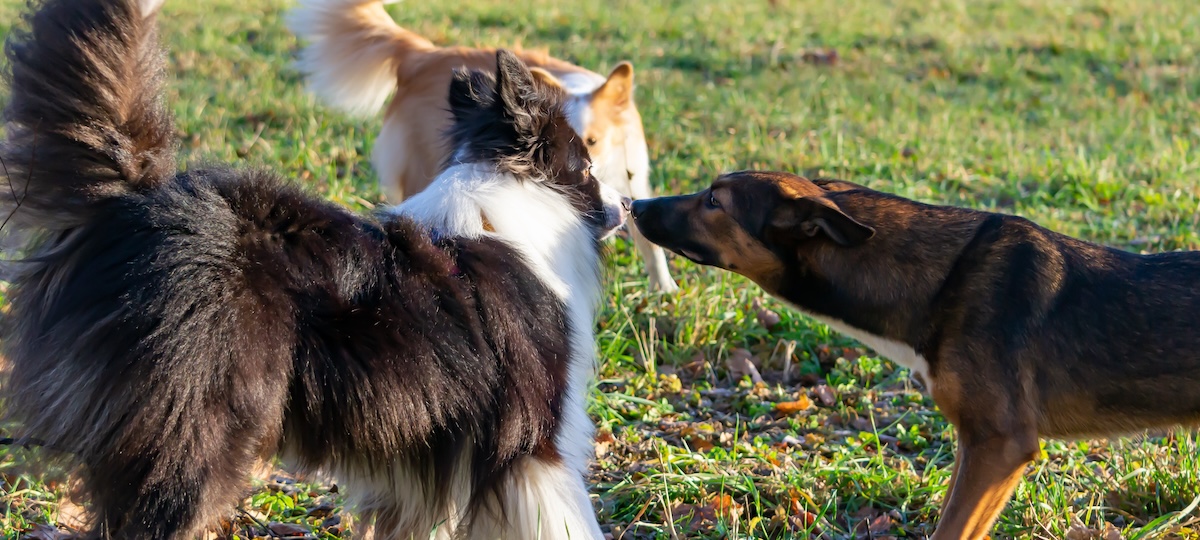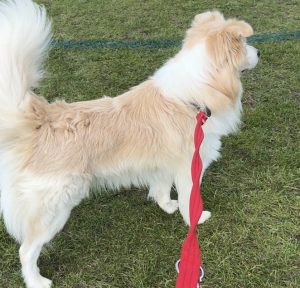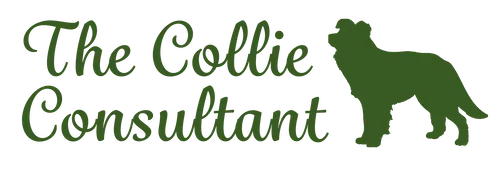
Understanding what’s going on
Entire (unneutered) male dog agression often occurs in collies and is characterised by tension, scuffles, or barking at other entire males — particularly during adolescence.
This can be worrying and often misunderstood. It’s easy to assume a dog is being “dominant” or “protective,” but in reality, the reasons are far more complex and emotional.
As a behaviourist who works extensively with Border Collies and other sensitive breeds, I see this pattern often: a bright, eager adolescent male who wants to do the right thing, but whose body and brain are flooded with hormones, making calm decision-making almost impossible. I see it occasionally in my own border collie, Ozzy, now age 2 and a few months.
Hormones amplify emotions
Testosterone itself doesn’t “cause” entire male dog aggression. What it does is turn up the volume on all emotions — excitement, frustration, irritation, and even fear.
During adolescence (roughly 9–24 months), an entire male’s hormonal balance changes dramatically. His brain becomes more reactive, his arousal levels rise, and his ability to control impulses temporarily dips. And just like teenage humans, he starts to take more risks – and being aggressive to another dog is a risk – it could backfire and he may be injured.
When two entire males meet, both are more likely to posture or stiffen, and if neither looks away, a stand-off can easily escalate.
It’s often about social insecurity, not dominance
Many entire males who appear “confident” are actually socially unsure. They may want to greet but feel tense about what will happen next.
This inner conflict — the urge to approach and the fear of what might follow — is called approach–avoidance conflict.
When adrenaline and testosterone mix, dogs feel unsure about how to react and so may lunge or bark to try to control the situation. In other words, they are communicating “I’m not sure what to do, so I’ll make you go away.”
Sensitive breeds like Border Collies can be particularly prone to this because they have been bred to work closely with their humans, and pay more attention to subtle body language than other breeds.
The influence of nearby females in season

The scent of female dogs in season can carry for a long way.
Entire males pick up that pheromone signal and their brains respond automatically, in a way that they can’t control. Their testosterone rises and their adrenaline surges so that they struggle to concentrate on anything else.
They are not intentionally shutting out everything else – they can’t help it.
If a male dog can’t reach the enticing lady, he can become extremely frustrated and restless. Another entire male nearby may then be viewed as competition, and normal tension between males increases.
Even after the females’ season has passed, a dog’s arousal can remain heightened for several weeks.
Ozzy, my two year old collie, has very occasional aggressive outbursts, and they have all been when one of the girls he lives with has been in season.
Pain and frustration lower tolerance
Pain can be a major, often overlooked cause or contributor to this behaviour.
A dog who’s sore or uncomfortable has a lower threshold for coping. If another dog bumps them, or if they feel physically restricted, they may react more sharply.
In behaviour work, pain is one of the first things I think about in collies with severe behaviour problems, because unresolved discomfort can fuel both aggression towards people, other dogs or traffic, as well as repetitive behaviours such as spinning, shadow chasing, or fly snapping.
When hormones, fear, and frustration combine
An entire male who’s socially insecure, physically uncomfortable, and exposed to hormonal scent cues is living with constant internal tension.
That tension can spill over as reactivity towards other dogs — especially other entire males.
Over time, the more often he practises this reaction, the faster it happens.
That’s why management is key: we want to prevent rehearsal of the behaviour while working on his emotional wellbeing.
What helps
- Distance and predictability: Keep space between him and other entire males for now. Calm, controlled walks matter more than exposure. Try to go to places where all other dogs are on lead so that it is easy to manage interactions. Stately homes, nature reserves or town centres are ideal.
- Pain check: Always rule out discomfort — musculoskeletal, skin, or gut-related pain can all lower thresholds for aggression.
- Harness and long line: Protect the neck and prevent self-rewarding lunges.
- Focus on calm engagement: Pattern games will help dogs to learn to regulate their emotions and teach quiet connection.
- Avoid high arousal play: Fast ball games or chase play increase adrenaline, making reactivity worse.
- Keep a note: If his behaviour worsens every few months, there may be nearby females in season — mark these on a calendar so that you know why it might be occurring if you start to see a pattern.
- Consider timing of neutering carefully: Castration can reduce aggressive behaviour if it is driven by a dog’s sexual hormones. However, if an aspect of their behaviour is due to fear or anxiety, losing their testosterone may worsen fear-based. Always discuss with your behaviourist and vet before making your decision. If you really want to do it, consider trying the 6-month hormonal implant first. Then if his behaviour deteriorates, you know it won’t be permanent.
Compassion and context
When we see an entire male reacting to another dog, we’re observing a biological and emotional outburst that is out of his control. We need to understand the emotions underneath — fear, conflict, and discomfort — and help him through with patience and empathy – it’s a very stressful state for him.
If we can prevent him from practising the behaviour, and keep him a good distance away from other young entire males until adolescence passes, he should start to improve dramatically.
References
- Beaver, B. (2009). Canine Behavior: A Guide for Veterinarians. Saunders.
- Case, L.P. (2020). The Dog: Its Behavior, Nutrition, and Health (3rd ed.). Wiley.
- LeBreux, B. (2022). “Behavioural challenges during canine adolescence.” Journal of Veterinary Behavior, 51, 75–83.
- McGreevy, P. & Boakes, R. (2011). Carrots and Sticks: Principles of Animal Training. Cambridge University Press.
- Neilson, J. (2003). “Reproductive behaviour problems in male dogs.” Clinical Techniques in Small Animal Practice, 18(2), 62–68.
- Ogata, N. (2016). “Neurobiology of canine aggression.” Veterinary Pathology, 53(1), 49–60.
- Overall, K. (2013). Manual of Clinical Behavioral Medicine for Dogs and Cats. Elsevier.
- Rosado, B., et al. (2010). “Behavioural assessment of canine aggression influenced by gonadal status.” Applied Animal Behaviour Science, 123(3–4), 157–162.
- Sherman, B.L. & Mills, D.S. (2008). “Canine aggression.” Veterinary Clinics of North America: Small Animal Practice, 38(5), 983–1003.

